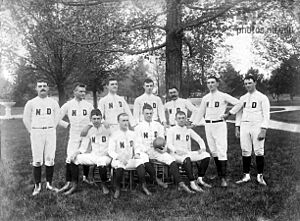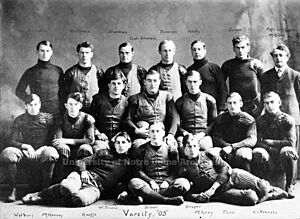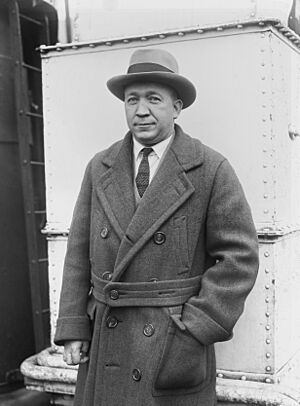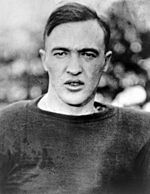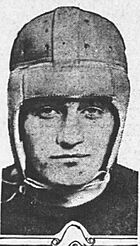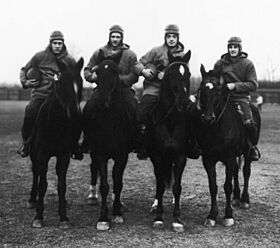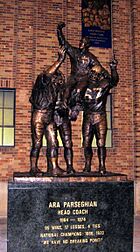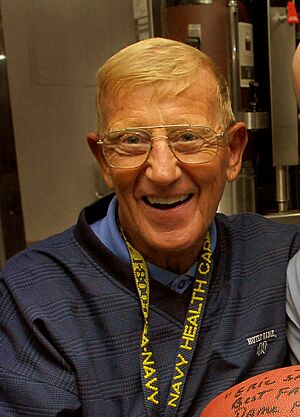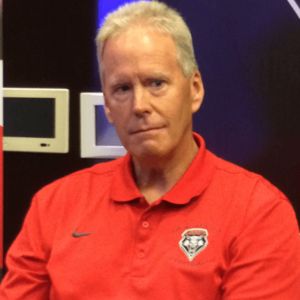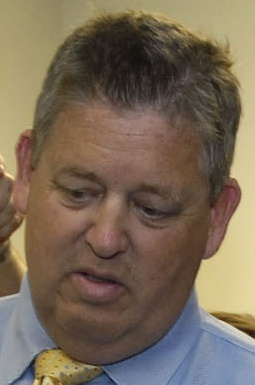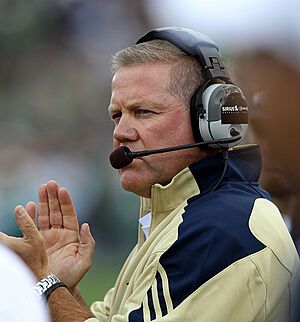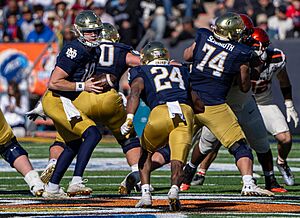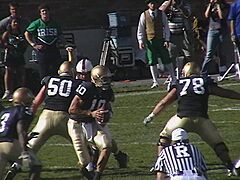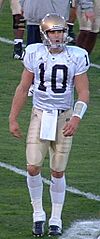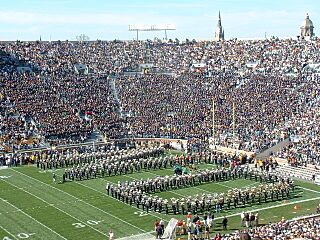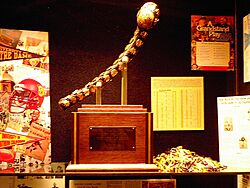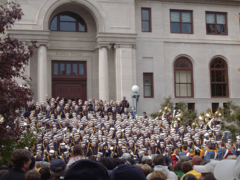Notre Dame Fighting Irish football facts for kids
Quick facts for kids Notre Dame Fighting Irish football |
|||
|---|---|---|---|
|
|||
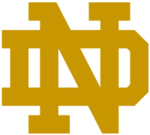 |
|||
| First season | 1887; 138 years ago | ||
| Athletic director | Pete Bevacqua | ||
| Head coach | Marcus Freeman 4th season, 33–10 (.767) |
||
| Stadium | Notre Dame Stadium (capacity: 77,622) |
||
| Field | Notre Dame Stadium | ||
| Year built | 1930 | ||
| Field surface | Natural grass (1930–2013) FieldTurf (2014–present) |
||
| Location | Notre Dame, Indiana | ||
| NCAA division | Division I FBS | ||
| Conference | Independent | ||
| Past conferences | ACC (2020) | ||
| All-time record | 962–339–42 (.732) | ||
| Bowl record | 22–21 (.512) | ||
| Playoff appearances | 3 (2018, 2020, 2024) | ||
| Playoff record | 3–3 | ||
| Claimed national titles | 11 (1924, 1929, 1930, 1943, 1946, 1947, 1949, 1966, 1973, 1977, 1988) | ||
| Unclaimed national titles | 12 (1919, 1920, 1927, 1938, 1953, 1964, 1967, 1970, 1989, 1993, 2012) | ||
| National finalist | 2 (2012, 2024) | ||
| Rivalries | Army (rivalry) Boston College (rivalry) Miami (rivalry) Michigan (rivalry) Michigan State (rivalry) Navy (rivalry) Northwestern (rivalry) Pittsburgh (rivalry) Purdue (rivalry) Stanford (rivalry) USC (rivalry) |
||
| Heisman winners | Angelo Bertelli – 1943 Johnny Lujack – 1947 Leon Hart – 1949 Johnny Lattner – 1953 Paul Hornung – 1956 John Huarte – 1964 Tim Brown – 1987 |
||
| Consensus All-Americans | 109 | ||
| Current uniform | |||
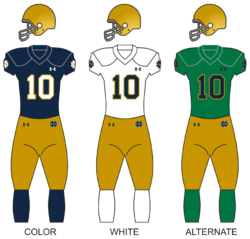 |
|||
| Colors | Blue and Gold |
||
| Fight song | Notre Dame Victory March | ||
| Mascot | Notre Dame Leprechaun | ||
| Marching band | Band of the Fighting Irish | ||
| Outfitter | Under Armour | ||
The Notre Dame Fighting Irish football team represents the University of Notre Dame in Notre Dame, Indiana. They play their home games at Notre Dame Stadium, which holds 77,622 fans. Notre Dame is one of only three schools that plays as an independent team in the top level of college football, the Football Bowl Subdivision (FBS). However, they play five games each year against teams from the Atlantic Coast Conference (ACC), which Notre Dame is a member of for most other sports.
The Fighting Irish are one of the most famous college football teams ever. Since their first season in 1887, Notre Dame has won 11 national championships. Seven Notre Dame players have won the Heisman Trophy, an award for the best college football player. Notre Dame has 962 official wins, with 21 wins from 2012 and 2013 later removed by the NCAA due to academic issues. Notre Dame has had 22 seasons where they didn't lose any games, including 12 perfect seasons. Their home games have been shown on NBC since 1991.
Contents
- Team History
- Early Years (1887–1917)
- The Knute Rockne Era (1918–1930)
- Heartley Anderson Era (1931–1933)
- Elmer Layden Era (1934–1940)
- Frank Leahy Era (1941–1953)
- Terry Brennan Era (1954–1958)
- Joe Kuharich Era (1959–1963)
- Ara Parseghian Era (1964–1974)
- Dan Devine Era (1975–1980)
- Gerry Faust Era (1981–1985)
- Lou Holtz Era (1986–1996)
- Bob Davie Era (1997–2001)
- Tyrone Willingham Era (2002–2004)
- Charlie Weis Era (2005–2009)
- Brian Kelly Era (2010–2021)
- Marcus Freeman Era (2021–Present)
- Team Uniforms
- Stadium and Facilities
- Rivalries
- Game Day Traditions
- Irish in the NFL
- Media Coverage
- Future Games
Team History
Early Years (1887–1917)
Football at Notre Dame started with a tough loss on November 23, 1887, when they fell to Michigan 8–0. Their first win was in 1888, beating Harvard Prep School of Chicago 20–0. By 1899, Notre Dame had a record of 31 wins, 15 losses, and 4 ties. In 1894, James L. Morrison became Notre Dame's first head coach. He helped the team become more serious about football.
In 1908, Fay Wood caught the first touchdown pass in Notre Dame history. In 1909, Notre Dame beat Michigan 11–3, after which Michigan refused to play them for 33 years. By 1912, Notre Dame had 108 wins, 31 losses, and 13 ties.
Jesse Harper coached from 1913 to 1917. During his time, the Irish only played against other colleges and had a record of 34 wins, 5 losses, and 1 tie. This period also started rivalries with Army and Michigan State. Harper wanted Notre Dame to be a national powerhouse, so he scheduled games against strong teams like Texas, Penn State, and Army.
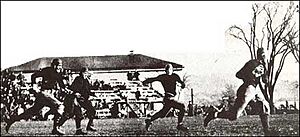
On November 1, 1913, Notre Dame surprised Army with a 35–13 win. Quarterback Gus Dorais and end Knute Rockne used a new way of throwing the forward pass. Instead of receivers stopping to wait for the ball, Dorais threw to Rockne while he was running. This changed the forward pass from a rare play to a key part of the game.
The Knute Rockne Era (1918–1930)
Irish assistant Knute Rockne became head coach in 1918. In his 13 years, the Irish won three national championships and had five undefeated seasons. They also won the Rose Bowl in 1925. Famous players like George Gipp and the "Four Horsemen" played for him.
Rockne's first game as coach was a 26–6 victory against Case Tech in 1918. The 1919 team went undefeated and was considered a national champion, though Notre Dame doesn't officially claim it.
George Gipp, known as "The Gipper," died at age 25 in 1920. He likely got sick after giving punting lessons. Rockne famously told his team to "Win one for the Gipper" in a later game.
The 1921 team, led by John Mohardt, had a 10–1 record. They were one of the first teams to build their offense around the forward pass.
The 1924 team, which won a national championship, included the famous "Four Horsemen" backfield: Harry Stuhldreher, Don Miller, Jim Crowley, and Elmer Layden. Their offensive line was called the "Seven Mules." They finished a perfect 10–0 season by beating Stanford in the 1925 Rose Bowl.
In 1928, Rockne gave his famous "Win one for the Gipper" speech to inspire his team against Army. Notre Dame was having a tough season, but they upset Army 12–6 after the speech.
The 1929 and 1930 teams were both undefeated and won national championships. The 1930 team was special because all four players in its backfield were named All-Americans. The 1929 team played all its games away while the new Notre Dame Stadium was being built. In 1930, "Jumping Joe" Savoldi scored the first touchdown in the new stadium.
Rockne coached his last game in December 1930. He died in a plane crash in Kansas on March 31, 1931, at age 43. He had the highest winning percentage (.881) for a football coach in the FBS division for many decades. He had 105 wins, 12 losses, 5 ties, and 3 national championships.
Heartley Anderson Era (1931–1933)
After Rockne's death, assistant coach Heartley "Hunk" Anderson became head coach. He led the team to 16 wins, 9 losses, and 2 ties. In 1931, Notre Dame lost to USC, ending their 26-game unbeaten streak. The 1933 season was tough, with a 3–5–2 record, the program's first losing season since 1888. Anderson resigned after the 1933 season.
Elmer Layden Era (1934–1940)
Elmer Layden, one of Rockne's "Four Horsemen," took over as coach. His 1935 team had a famous comeback win against Ohio State in a game called the "Game of the Century." His 1938 team finished 8–1 and was named national champion by one system, though they lost their last game to USC.
Layden helped fix the rivalry with Michigan, which had stopped playing Notre Dame in 1909. Layden left Notre Dame after the 1940 season to become the Commissioner of the National Football League. He had 47 wins, 13 losses, and 3 ties, the most successful record for a Notre Dame coach who didn't win a national championship.
Frank Leahy Era (1941–1953)
Frank Leahy, a former Irish player under Rockne, became head coach in 1941. He had already coached Boston College to a national championship. Leahy brought great success back to Notre Dame.
His 1943 team went 9–1 and won Notre Dame's fourth national championship. Quarterback Angelo Bertelli became Notre Dame's first Heisman Trophy winner. Leahy served in the U.S. Navy during World War II from 1944 to 1945. During his absence, Edward McKeever coached in 1944 (8–2 record), and Hugh Devore coached in 1945 (7–2–1 record).
When Leahy returned in 1946, Notre Dame recruited many older veterans who had served in the war. This helped the team go four seasons without a loss after World War II, winning national championships in 1946, 1947, and 1949. The 1946 game against Army, a 0–0 tie, was a clash of two legendary teams. The 1948 team almost won a national championship but tied USC in their final game. In 1949, Notre Dame went undefeated again, led by Heisman winner Leon Hart.
Leahy retired in 1954 due to health issues. He had the second-highest winning percentage (.864) of any college coach in history. He led the Irish to 87 wins, 11 losses, and 9 ties, including a 39-game unbeaten streak. He won four national championships and had six undefeated seasons.
Terry Brennan Era (1954–1958)
Terry Brennan, a 25-year-old assistant and former player under Leahy, became head coach in 1954. His first two seasons were strong, with the Irish finishing fourth and ninth in the AP poll. However, the 1956 season was tough, with only two wins. Despite this, Paul Hornung won the Heisman Trophy that year, the only Heisman winner from a losing team.
The Irish improved in 1957, with a 7–3 record, including a big upset win over Oklahoma that ended their 47-game winning streak. Brennan's final season in 1958 ended 6–4, and he was fired. He had 32 wins and 18 losses. During his time, Notre Dame's administration reduced football scholarships, making it harder to build a deep team.
Joe Kuharich Era (1959–1963)
Joe Kuharich, a former Irish player, became head coach in 1959. He tried to bring a professional football style to the college game. However, his time was one of the worst for the program, including an eight-game losing streak in 1960. Many felt he didn't adjust well to college football. He resigned in 1963.
Kuharich had a 17–23 record, the only coach with a losing record at Notre Dame. Despite this, he was the only Irish coach to have back-to-back shutouts against rival USC in 1960 and 1961.
Ara Parseghian Era (1964–1974)
In 1964, Ara Parseghian became Notre Dame's head coach. He quickly brought the team back to the top, similar to Rockne and Leahy. Parseghian's teams always won at least seven games and never lost more than three.
In his first year, 1964, the Irish improved to 9–1, led by Heisman winner John Huarte. Parseghian won coach of the year awards. The 1966 team went undefeated and won the national championship. This season is famous for the 10–10 tie against #2 Michigan State, known as the "Game of the Century."
Under Parseghian, Notre Dame ended its 40-year policy of not playing in bowl games. They played in the Cotton Bowl Classic after the 1969 season, losing a close game to #1 Texas. The next year, they beat Texas in the Cotton Bowl. In 1971, Cliff Brown became the first African-American quarterback to start for Notre Dame.
The Irish won Parseghian's second national championship in 1973, going 10–0 in the regular season and beating #1 Alabama in the Sugar Bowl. Parseghian retired after the 1974 season due to health issues.
During his 11 years, Parseghian had a record of 95–17–4 and won two national championships. He was inducted into the College Football Hall of Fame in 1980.
Dan Devine Era (1975–1980)
Dan Devine became head coach after Parseghian retired. He had already been a successful coach for other teams. Devine led the Irish to 53 wins, 16 losses, and 1 tie, with three bowl victories.
His biggest achievement was leading the 1977 Notre Dame team to a national championship. Before the game against USC, Devine changed the team's jerseys from blue to kelly green and gold. This became known as the "green jersey game," and Notre Dame won 49–19. The championship season ended with a 38–10 win over previously top-ranked Texas in the Cotton Bowl Classic.
In 1978, the Irish made a huge comeback in the Cotton Bowl against Houston, winning 35–34 after being down by 22 points in the fourth quarter. This game was called the "Chicken Soup Game" because quarterback Joe Montana ate chicken soup at halftime while sick. Devine announced in August 1980 that he would leave Notre Dame at the end of the season.
Gerry Faust Era (1981–1985)
Gerry Faust was a surprising choice to replace Devine in 1981. He was a very successful high school coach. However, his time at Notre Dame was mixed. In his first season, the Irish finished 5–6. The best years under Faust were 1983 and 1984, when the Irish finished 7–5 and played in bowl games. His final record was 30–26–1. Faust resigned at the end of the 1985 season.
Lou Holtz Era (1986–1996)
Lou Holtz became head coach in 1986. He was known as a great motivator and a strict leader. His first season, 1986, was 5–6, but five of those losses were by very small margins. After that, he had a record of 95–24–2 over the next ten seasons, for a total of 100–30–2.
In 1987, Holtz led the Irish to an 8–4 record. Tim Brown won the Heisman Trophy that season, Notre Dame's most recent Heisman winner.
The 1988 season was very successful. The Irish beat the reigning national champion Miami Hurricanes 31–30 in a famous game known as "Catholics vs. Convicts." Holtz led the Irish to a 12–0 record and a win over West Virginia in the Fiesta Bowl, winning Notre Dame's 11th national championship. 1988 is still Notre Dame's most recent undefeated season and national championship.

In 1989, the Irish went 12–1. They started 11–0 before losing to Miami, ending their 23-game winning streak. They finished the season by beating Colorado in the Orange Bowl.
The 1990 season started with a #1 ranking, but losses to Stanford, Penn State, and Colorado kept them from a national championship. In 1992, Notre Dame finished 10–1–1 and beat Texas A&M in the Cotton Bowl.
The 1993 season was another strong one, with an 11–1 record. They beat #1 Florida State 31–24 in a classic game. However, a last-second loss to Boston College ended their national championship hopes. They finished #2 in the AP poll, even though they had beaten the #1 team.
Holtz retired from Notre Dame after the 1996 season. He led Notre Dame to one undefeated season, nine straight New Year's Day bowl games, and five top-10 finishes.
Bob Davie Era (1997–2001)
Bob Davie, Holtz's defensive coordinator, became head coach in 1997. His team lost three bowl games and missed two others. A highlight was a 36–20 upset win over #5 Michigan in 1998, who were the defending national champions.
In 1999, Notre Dame was put on probation by the NCAA due to rule violations. Davie's team nearly beat top-ranked Nebraska in 2000, losing in overtime. The 2001 Fiesta Bowl was Notre Dame's first invitation to the Bowl Championship Series, but they lost badly to Oregon State. Davie was fired after the 2001 season, with a final record of 35–25.
George O'Leary Controversy
On December 9, 2001, Notre Dame hired George O'Leary as head coach. However, it was discovered that O'Leary had lied on his resume. He resigned five days later, before coaching any practices or recruiting any players.
Tyrone Willingham Era (2002–2004)
The school then hired Tyrone Willingham from Stanford, making him the first African American head coach in Notre Dame football history. Willingham's 2002 team started 8–0, including wins over #7 Michigan and #11 Florida State, and reached a #4 ranking. This strong start was the main highlight of his time. The team finished 10–2 in the regular season but lost their last three games.
Over the next two seasons, the team struggled, with an 11–12 record. Willingham's recruiting classes were also considered weak. He was fired on November 30, 2004.
Charlie Weis Era (2005–2009)
Charlie Weis left the NFL's New England Patriots, where he had won three Super Bowls as an offensive coordinator, to become Notre Dame's head coach in 2005. He was the first Notre Dame graduate to be the head football coach since Joe Kuharich.
In his first season, 2005, Weis led the Irish to two road wins against ranked teams. In a famous game against USC, the Irish lost 34–31 in a play known as the "Bush Push." The Irish finished 9–3 and #9 in the AP poll. Quarterback Brady Quinn broke many team passing records. Weis signed a long contract extension that year.
The 2006 team started with a #2 ranking and finished 10–2, losing only to Michigan and USC. They lost to LSU in the Sugar Bowl, marking their ninth straight postseason loss. The 2007 season was very tough, with 9 losses, the most in a single year. They also lost to Navy, ending Notre Dame's NCAA-record 43-game winning streak against them.
In 2008, the Irish finished 6–6 but broke their bowl losing streak by beating Hawaii 49–21 in the Hawaii Bowl. Weis was fired on November 30, 2009, after the team finished 6–6.
Brian Kelly Era (2010–2021)
On December 10, 2009, Brian Kelly became the 31st head coach of the Fighting Irish. In his first season, 2010, Kelly led the team to an 8–5 record. A sad event happened early in the season when a student worker died while filming practice in high winds. Kelly guided the Irish to a 33–17 win over Miami (FL) in the 2010 Sun Bowl. The 2011 season also ended 8–5.
In 2012, Notre Dame announced it would join the Atlantic Coast Conference (ACC) for most sports, but football would remain independent. However, the football team agreed to play five games per season against ACC teams starting in 2014.
The 2012 season was historic. The Irish started 7–0, including wins over ranked rivals. They reached #1 in the nation after an 11–0 regular season, their first since 1993. They finished 12–0 and played in the BCS National Championship Game for the first time, losing to Alabama 42–14. The defense was very strong, led by Manti Te'o, who finished second in Heisman Trophy voting.
The 2013 season ended 9–4 with a bowl win. The 2014 season started 6–0 but ended 8–5 after losing four of their last five regular season games. They won the Music City Bowl against LSU.
The 2015 team started 10–1 and was close to making the College Football Playoff but lost a close game to Stanford. They lost to Ohio State in the Fiesta Bowl. The 2016 season was Kelly's worst at Notre Dame, with a 4–8 record.
The 2017 season was much better, with a 10–3 record. They had a strong running game and a great offensive line. The 2018 season saw Notre Dame go undefeated in the regular season (12–0) and make the College Football Playoff semifinal, where they lost to Clemson. Kelly was named AP Coach of the Year.
In 2019, the Irish finished 11–2 with a bowl win. In 2020, due to the COVID-19 pandemic, Notre Dame played a full ACC schedule. They went 10–0 in the regular season, beating #1 Clemson. They lost to Clemson in the ACC Championship Game but still made the College Football Playoff as the #4 seed, losing to Alabama. In 2021, Kelly's final season, the Irish finished 11–1 in the regular season.
On November 29, 2021, Kelly resigned to become head coach at LSU. He left as Notre Dame's all-time winningest head coach.
Marcus Freeman Era (2021–Present)
On December 3, 2021, Notre Dame's defensive coordinator Marcus Freeman was promoted to head coach. He became the second African American head coach in the program's history. Freeman coached the team in their Fiesta Bowl loss to Oklahoma State.
Freeman's 2022 season started with three losses, a first for a Notre Dame head coach. However, the team improved, finishing 8–4 and upsetting #5 Clemson. They won the Gator Bowl against South Carolina. In 2023, Freeman led Notre Dame to a 10-win season. Safety Xavier Watts won the Bronko Nagurski Trophy as the best defensive player.
The 2024 season saw the Irish start with a surprising home loss to Northern Illinois. However, they won every remaining regular season game, finishing 11–1. They hosted a home playoff game, beating Indiana 27–17. They then beat the SEC champion #2 Georgia Bulldogs in the Sugar Bowl 23–10, their first major bowl win since 1993. They followed this with a 27–24 win over #6 Penn State in the Orange Bowl, reaching the 2025 National Championship Game. They lost the championship game to Ohio State 34–23. Watts was named a consensus All-American for the second year, and Freeman won national coach of the year awards.
Team Uniforms
Notre Dame's home jersey is navy blue with white numbers and gold outlines. The away jersey is white with navy numbers and gold outlines. Both have a small "ND" logo on the sleeves. These uniforms were introduced by Lou Holtz in 1986.
The Irish usually do not have player names on their jerseys for regular season games. However, they did during the coaching times of Dan Devine (1975–80) and Gerry Faust (1981-85). For bowl games, player names are sometimes added.
Notre Dame's helmets are solid gold with gray facemasks, representing the university's famous "Golden Dome." Until 2011, student managers would spray-paint the helmets before each game. Now, a company does it, using gold particles from the 2007 re-gilding of the Golden Dome.
No uniform numbers have been officially retired by Notre Dame. However, some numbers are very famous because of the great players who wore them. Number 3 has been worn by many famous quarterbacks like Joe Montana. Number 5 was worn by a "Four Horseman" (Elmer Layden) and a Heisman Trophy winner (Paul Hornung).
In 2011, Notre Dame and Michigan wore special throwback uniforms when they played each other. For their "Shamrock Series" games, Notre Dame wears unique alternate uniforms.
Green Jerseys
Notre Dame has sometimes worn green jerseys instead of blue for home games. They officially became an alternate color in 1942.
Today, Notre Dame saves its green jerseys for special games. Sometimes, the team will warm up in blue jerseys, then switch to green before the game starts. This tradition began in 1977. Notre Dame has also changed jerseys at halftime, like in the 1985 USC game. As of 2023, Notre Dame's record in green jerseys is 42-15-1.
Stadium and Facilities
Notre Dame Stadium
Notre Dame Stadium is the home of the Fighting Irish football team. It is located on the university's campus and is one of the most famous college football stadiums. It is used for football and for graduation ceremonies. The stadium did not have permanent lights until 1997, paid for by NBC, which broadcasts Notre Dame home games. In 2014, the grass field was replaced with a synthetic turf. A large expansion project, the Crossroads Campus Project, was finished in 2017.
Guglielmino Athletics Complex
Fans call this building "The Gug." It is Notre Dame's football headquarters. It has offices for staff, an auditorium, a weight room, a training room, and locker rooms.
Irish Athletic Center
This indoor practice facility has a synthetic turf field and a large video board. It is 111,400 square feet with a 95-foot-high ceiling.
Rivalries
Notre Dame has many rivalries, even though they play as an independent team. They play against teams like Army, Boston College, Michigan, Michigan State, Navy, Purdue, Stanford, and USC.
Miami (FL)
Notre Dame and the Miami Hurricanes first played in 1955. They played every year from 1971 to 1990. Notre Dame usually won in the 1970s, but Miami became very strong in the 1980s. Both teams were top contenders and often affected each other's chances for national championships. The rivalry became very intense. The 1988 game, known as "Catholics vs. Convicts," was won by Notre Dame 31–30. The rivalry ended after 1990. They are scheduled to play again in 2025.
Michigan
The first game between Notre Dame and Michigan was in 1887. They have played 44 times. Both schools are among the top five in all-time winning percentage in Division I football.
Michigan State
Notre Dame and Michigan State first played in 1897. They play for the Megaphone Trophy. A famous game was the 1966 "Game of the Century". Notre Dame leads the series 48–28–1.
Navy and Notre Dame played every year from 1927 to 2019. Notre Dame had a 43-game winning streak against Navy, the longest in Division I-A football history against one opponent, which ended in 2007. The series continued in 2021 after a break in 2020. Notre Dame leads the series 83–13–1.
USC
USC is Notre Dame's main rival. They play every year for the Jeweled Shillelagh. This rivalry is considered one of the most important in college football. Famous games include the 1977 "Green Jersey" game and the 2005 "Bush Push" game. Notre Dame leads the series 50–37–5.
Game Day Traditions
Notre Dame football has many special traditions:
- The helmets are painted with 23.9 karat gold particles collected from the re-gilding of the Golden Dome in 2007.
- Before home games, the team attends Mass. Fans line up to cheer for the team as they walk from the Guglielmino Athletics Complex to the stadium.
- The Band of the Fighting Irish trumpet section plays "Notre Dame, Our Mother" and the "Notre Dame Victory March" under the Golden Dome.
- Players slap the "Play Like a Champion Today" sign when they leave the locker room. This sign was started by coach Lou Holtz in 1986.
- Before the game starts, a song called "Here Come The Irish" is played, followed by "I'm Shipping Up To Boston."
- Between the third and fourth quarters, the marching band plays music, and the crowd waves their arms in the shape of the current coach's first initial, which is an "F" for Marcus Freeman.
- From 1960 to 2015, Sergeant Tim McCarthy of the Indiana State Police gave a driving safety announcement during the fourth quarter, always ending with a pun.
- After every home game, the team salutes the student section by raising their helmets. Then, the band plays the Alma Mater, "Notre Dame, Our Mother," and those who stay sing along.
Irish in the NFL
Since the NFL started drafting players in 1936, 495 Notre Dame football players have been chosen by NFL teams. Notre Dame has had 65 players picked in the first round of the NFL draft, including five who were the very first pick overall.
Pro Football Hall of Fame
13 former Notre Dame players and one non-player alumnus have been inducted into the Pro Football Hall of Fame. This ties Notre Dame with USC for the most among all college football programs.
Media Coverage
The Fighting Irish are the only college or professional team to have all their games broadcast nationally on radio and their home games on television. Notre Dame made a special deal with NBC in 1990 to broadcast their home games. NBC's contract with Notre Dame was renewed in 2023 and will continue through the 2029 season. Some games are also shown on NBC's streaming service, Peacock.
Future Games
Notre Dame football is not a full member of the Atlantic Coast Conference (ACC), but they have an agreement to play about five ACC teams each season. This allows Notre Dame to play in ACC bowl games that are not part of the College Football Playoff. Notre Dame usually plays six home games, five away games, and one "Shamrock Series" home game in a major city. This schedule includes yearly games against rivals like USC, Stanford, and Navy.


